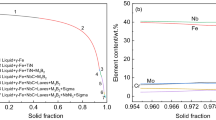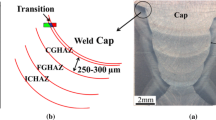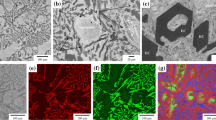Abstract
The ability of NbC and Laves phases to promote intergranular liquation cracking in the weld heat-affected zone (HAZ) of cast alloy 718 is examined in this paper. The term liquation cracking as used in this paper is synonymous with the terms microfissuring and hot cracking as used by the authors in previous papers. Many alloys are susceptible to intergranular liquation cracking due to the formation of incipient intergranular liquid films which can open into intergranular cracks. Previous studies on alloy 718 showed that both NbC and Laves phases produce intergranular liquid films when subjected to the rapid thermal cycles of the HAZ. When seeking a correlation between microstructure and liquation cracking, it is thus necessary to account for changes in the volume fractions and distributions of both NbC and Laves phases. The volume fractions and distributions of NbC and Laves phases were varied by heat treatment and also by using two bulk carbon concentrations. Increasing the bulk carbon from 0.02 to 0.06 wt pct caused a 70 pct increase in the volume fraction of NbC but no significant change in the amount of Laves phase. This increase in NbC was accompanied by an 18 pct increase in liquation cracking in the as-cast metal as measured using the spot varestraint test. When the volume fraction of NbC and Laves phases were varied using heat treatment, a very different behavior was observed. One hour heat treatments at 1200°F (649°C) and 1700°F (927 °C) reduced the amount of NbC by 40 pct, and the 1200°F (649°C) treatment also reduced the volume of Laves phase. Surprisingly, although the 1200°F (649°C) treatment reduced the amounts of both Laves phase and NbC, it produced a 23 pct increase in liquation cracking, while the 1700°F (927°C) treatment produced an opposite 22 pct decrease in liquation cracking. The effect of carbon content on the as-cast liquation cracking susceptibility is discussed in terms of its effect on the volume fraction of liquid produced during the welding thermal cycle and the subsequent resolidification kinetics of the liquid during cooling. The effects of different heat treatments are discussed in terms of their ability to redistribute solute, impurities, and precipitates within the matrix and to grain boundaries in deleterious or beneficial ways.
Similar content being viewed by others
References
D.S. Duvall and M.J. Donachie:J. Inst. Met., 1972, vol. 100, p. 6.
M.C. Chaturvedi and Y. Han:Met. Sci., 1983, vol. 17, p. 145.
D.S. Duvall and W.A. Owczarski:Weld. J., 1967, vol. 46, p. 423-s.
W.A. Owczarski, D.S. Duvall, and C.P. Sullivan:Weld. J., 1966, vol. 45, p. 145-s.
E.G. Thompson:Weld. J., 1969, vol. 48 (2), p. 70-s.
P.J. Valdez and J.B. Steinmen:Effects of Minor Elements on the Weldability of High-Nickel Alloys, Welding Research Council, New York, NY, 1969, p. 93.
R.G. Thompson and S. Genculu:Weld. J., 1983, vol. 62, p. 337s.
R. Vincent:Acta Metall., 1985, vol. 33, p. 1205.
W.A. Baeslack III and D.E. Nelson:Metallography, 1986, vol. 19, p. 371.
B. Radhakrishnan and R.G. Thompson:Metallography, 1988, vol. 21, p. 453.
R.G. Thompson, J.R. Dobbs, and D.E. Mayo:Weld. J., 1986, vol. 65, p. 299s.
D.E. Mayo: Master’s Thesis, University of Alabama at Birmingham, Birmingham, AL, 1987.
R.G. Thompson, B. Radhakrishnan, and D.E. Mayo:J. Phys., vol. 49, coll. C5, suppl. no. 10, Oct. 1988, pp. 471–79.
T. Kelly:Int. Welding Research Conf., Gatlinburg, TN, ASM, Metals Park, OH, 1986.
R.G. Thompson, J.J. Cassismus, D.E. Mayo, and J.R. Dobbs:Weld. J., 1985, vol. 64, p. 91s. 16. B. Radhakrishnan and R.G. Thompson: Metall. Trans. A, in press.
G.A. Knorovsky, M.J. Cieslak, T.J. Headley, A.D. Romig, Jr., and W.F. Hammerten.Metall. Trans. A, 1989, vol. 20A, pp. 2149–58. 18. B. Radhakrishnan and R.G. Thompson: Metall. Trans. A, in press.
G.R. Evers, H.H. Smith, and D.J. Michel:Metallography, 1978, vol. 11, p. 441.
W.J. Mills:Weld. J., 1984, vol. 63, p. 237s.
G. Muralidharan, R.G. Thompson, and S.D. Walck:Ultramicroscopy, 1989, vol. 29, p. 277.
R.A. Mulford:Metall. Trans. A, 1983, vol. 14A, p. 865.
W.F. Savage, E.F. Nippes, and G.M. Goodwin:Weld. J., 1977, vol. 56, p. 245s.
C.D. Lundin, A.C. Lingenfelter, G.E. Grotke, G.G. Lessman, and S.J. Mathews:Weld. Res. Counc. Bull., 1982, no. 280, p. 1.
B. Radhakrishnan and R.G. Thompson:Metall. Trans. A, 1989, vol. 20A, pp. 2866–68.
Author information
Authors and Affiliations
Additional information
Formerly Graduate Student, University of Alabama
Rights and permissions
About this article
Cite this article
Thompson, R.G., Mayo, D.E. & Radhakrishnan, B. The relationship between carbon content, microstructure, and intergranular liquation cracking in cast nickel alloy 718. Metall Trans A 22, 557–567 (1991). https://doi.org/10.1007/BF02656823
Received:
Issue Date:
DOI: https://doi.org/10.1007/BF02656823




